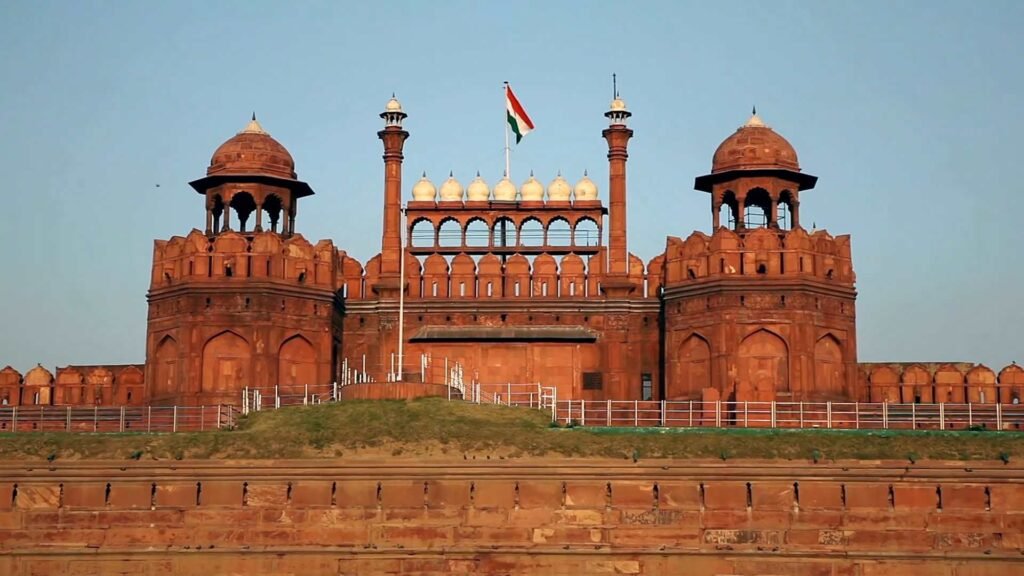
Absolutely, the Red Fort is definitely worth visiting! It’s an iconic landmark located in Delhi, India known for its unique architecture and historical significance. This magnificent fortress, constructed in red sandstone, showcases intricate designs and massive walls, offering stunning views of the surrounding landscape.
So, if you have the opportunity, I highly recommend visiting the Red Fort to admire its beauty and explore its fascinating history.
Table of Contents
Toggle1. Lesser Known Facts about Red Fort.
1. Symbol of History: The Red Fort in Delhi, India, is a UNESCO World Heritage Site and a powerful symbol of the country’s rich history.
2. Mughal Legacy: Built between 1638 and 1648 during the rule of Shah Jahan, the emperor behind the Taj Mahal, the Red Fort reflects Mughal architectural brilliance.
3. Original Name: Interestingly, the fort wasn’t always known as “Red Fort.” The Mughals originally named it “Qila-e-Mubarak,” which translates to “The Blessed Fort.”
4. Kohinoor’s Home: The Red Fort once housed the legendary Kohinoor diamond, part of the Peacock Throne, before it was taken by the British.
5. Baoli (Stepwell): The Red Fort houses a lesser-known baoli or stepwell, an ancient water storage system.
2. How to Reach Red Fort?
To reach the Red Fort, you have several options:
1. By Air: The nearest airport is Indira Gandhi International Airport in Delhi, which is about 20 kilometers away from the Red Fort. From there, you can take a taxi or a hired car to reach the fort.
2. By Train: The nearest railway station to the Red Fort is New Delhi Railway Station. From there, you can hire a taxi or use public transportation like buses to reach the fort.
3. By Road:
1. By Car: Take the road leading towards the Red Fort from Delhi city center. The drive should take approximately 30-40 minutes depending on traffic.
2. By Bus: Several public buses run between various parts of Delhi and the Red Fort. Some routes you can consider are:
- Kashmere Gate ISBT – Red Fort
- Chandni Chowk – Red Fort
- Daryaganj – Red Fort
The bus ride takes about 20-30 minutes, depending on the route and traffic.
3. By Metro: Delhi Metro is another convenient option to reach the Red Fort. You can take the Delhi Metro’s Violet Line and get off at the Lal Quila Metro Station, which is located just a short walk away from the Red Fort. This option is fast, efficient, and often avoids the city’s notorious traffic congestion.
4. By Auto-rickshaw: Take an auto-rickshaw from any part of Delhi city to the Red Fort. This option offers flexibility and a taste of local transportation.
3. Best time to visit Red Fort.
- The best time to visit the Red Fort is during the cooler months of November to February, when the weather is pleasant and comfortable for exploring the fort’s grounds and attractions. Avoiding the peak summer months of April to June is advisable due to the intense heat in Delhi. Additionally, visiting during weekdays or early mornings can help avoid crowds and enjoy a more peaceful experience.
4. Travel tips to Red Fort.
1. Plan Your Visit: Start early to beat the crowds and the heat, especially during peak tourist seasons.
2. Comfortable Clothing and Footwear: Wear light and comfortable clothing as you’ll be doing a lot of walking and climbing.
3. Stay Hydrated: Carry a water bottle to stay hydrated, especially if you’re visiting during the warmer months.
4. Carry some snacks and refreshments as there are limited food options available inside the fort. However, you’ll find Qila cafe available within the monument, though they may be priced slightly higher than those outside price.

5. To ensure a pleasant and respectful visit, please take note of the prohibited items as indicated on the signage throughout the Red Fort.

5. Map of Red Fort.
6. Places to visit at Red Fort.
1. Lahori Gate of Red Fort.

- Located on the western wall, Lahori Gate is the main entrance of the Red Fort Delhi. The name of this gate is derived from the fact that it faces towards the Lahore district of Pakistan.

- In 1947, Pandit Jawaharlal Nehru gave his first speech at this place. Since then, every Prime Minister speaks from here. Besides our national flag, another flag is also put up here, which is the flag of the Indian Army. It is raised by the army every morning and taken down in the evening.
- After entering the fort via Lahori Gate, one can see a covered market area called as Chatta Chowk.
2. Chhatta Chowk in Red Fort.
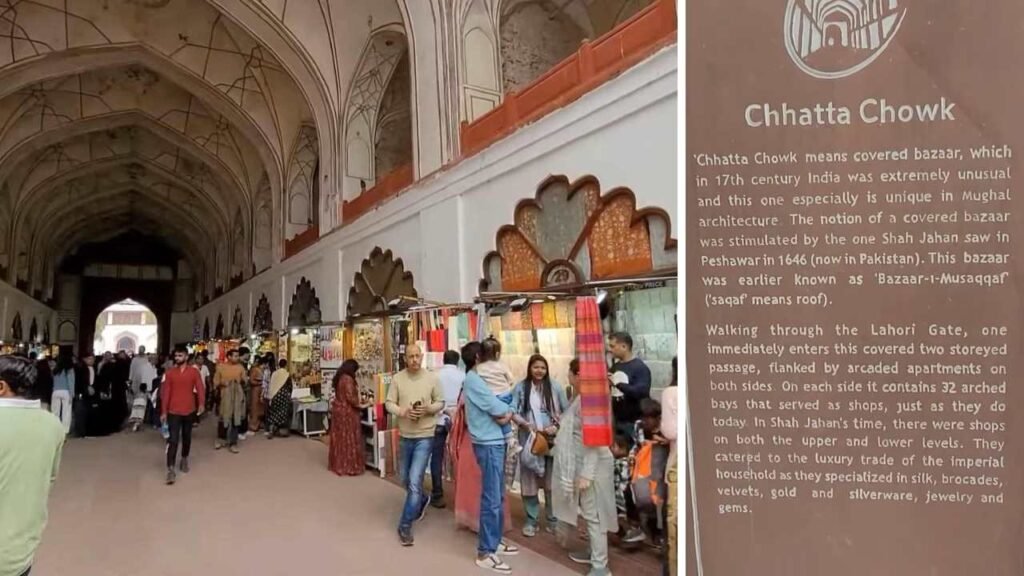
- “Chatta Chowk” basically means a covered market. It’s a long passage shaped like a curved roof. Chatta Chowk is like a big covered market located behind the Lahori Gate in Delhi’s Red Fort. An important part of Delhi Lal Kila, it presents a glimpse of unique Mughal architecture. This market has two floors with 32 arched sections where shops used to be.
3. Naubat Khana.

- After crossing Chhatta Chowk, you will reach the drum house called as Naqqar-Khana or Naubat. It is the place where ceremonial music used to be played. From here, one enters the Diwan-i-‘Am. There is Indian War Memorial Museum on its upper storey.
4. Diwan-i-Am.
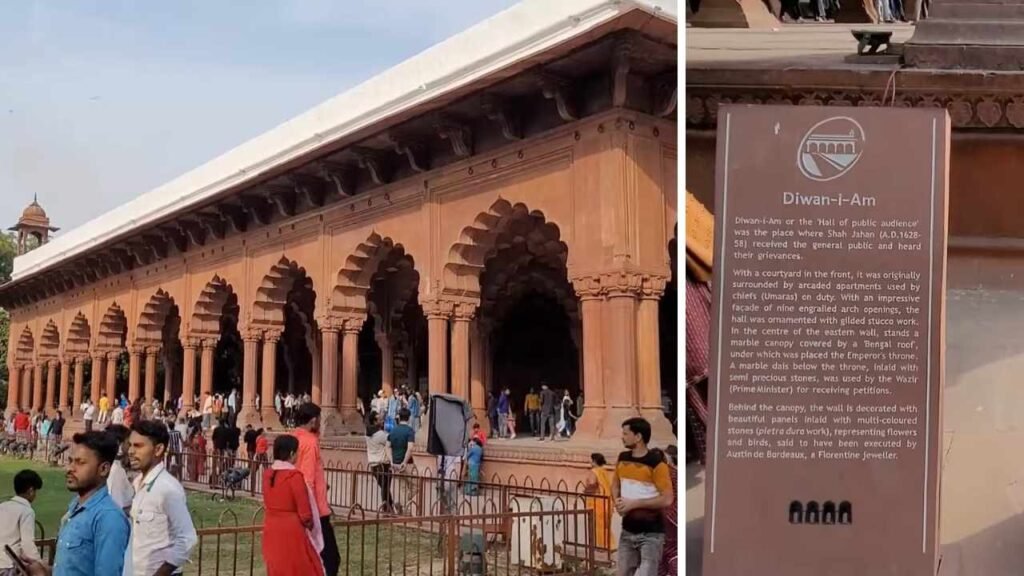
- Diwan-i-Aam, as the name suggests, is the hall of public audiences. This rectangular-shaped hall is the place where the Mughal emperor used to meet his subjects. A massive railing was built to separate the emperor from the people. Diwan-i-Aam has a raised area with a marble canopy where the emperor used to sit and listen to the complaints and issues of the people.
5. Rang Mahal.

- Red Fort’s Rang Mahal, known as the “Palace of Colours,” is one of the grand chambers which was later used as a dining hall by the British after they captured the fort. It is a large hall with an arched front and domed compartments on both the southern and northern ends.
- The ceilings of a few of the apartments here are decorated with small pieces of mirror, which is why it is also called Sheesh Mahal, meaning palace of mirrors.
7. Red Fort Delhi Timings.
| Day | Timing |
|---|---|
| Monday | Closed / Holiday |
| Tuesday | 9:30 am – 4:30 pm |
| Wedesday | 9:30 am – 4:30 pm |
| Thursday | 9:30 am – 4:30 pm |
| Friday | 9:30 am – 4:30 pm |
| Saturday | 9:30 am – 4:30 pm |
| Sunday | 9:30 am – 4:30 pm |
- For Red Fort online ticket click here – https://asi.payumoney.com/quick/red
8. Red Fort Delhi Entry Fee.
- 35 per person for Indians.
- 500 per person for Foreign Tourists.
- 25 for Video Camera.

9. Red Fort Light & Sound Show Timings.
- Hindi: 7.30 PM to 8.30 PM (May to Aug)
7 PM to 8 PM (Sep & Oct)
6 PM to 7 PM (Nov to Jan)
7 PM to 8 PM (Feb to Apr) - English: 9 PM to 10 PM (May to Aug)
8.30 PM to 9.30 PM (Sep & Oct)
7.30 PM to 8.30 PM (Nov to Jan)
8.30 PM to 9.30 PM (Feb to Apr)
10. Red Fort Light & Sound Show Entry Fee.
- 80 per person for adults on weekends (Light & Sound show)
- 30 per person for children on weekends (Light & Sound show)
- 60 per person for adults on weekdays (Light & Sound show)
- 20 per person for children on weekdays (Light & Sound show)
11. FAQs about Red Fort.
Q1. Why is Red Fort so special?
Ans. Red Fort is special for its rich history, Mughal architecture, and cultural significance as a UNESCO World Heritage Site, symbolizing India’s grandeur and serving as a historic landmark.

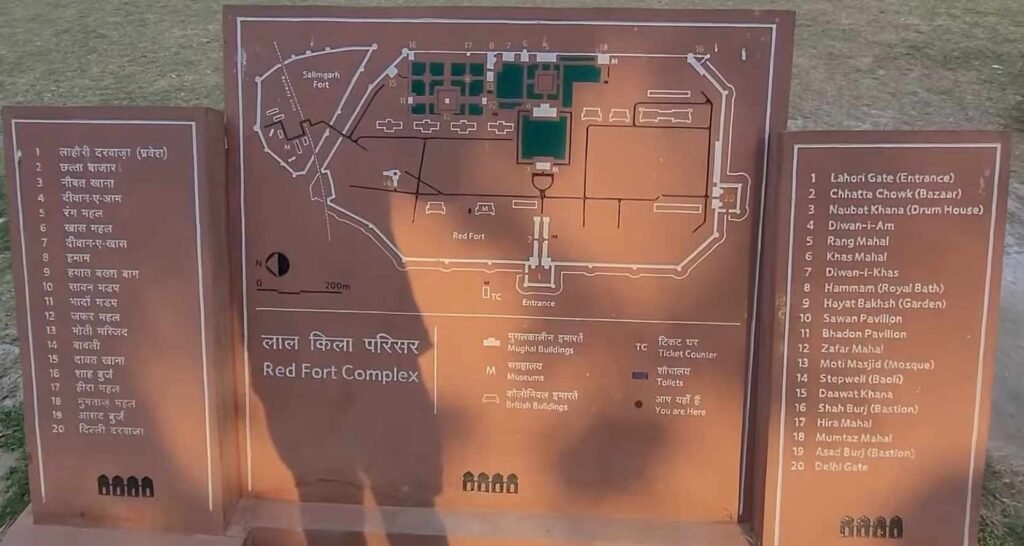
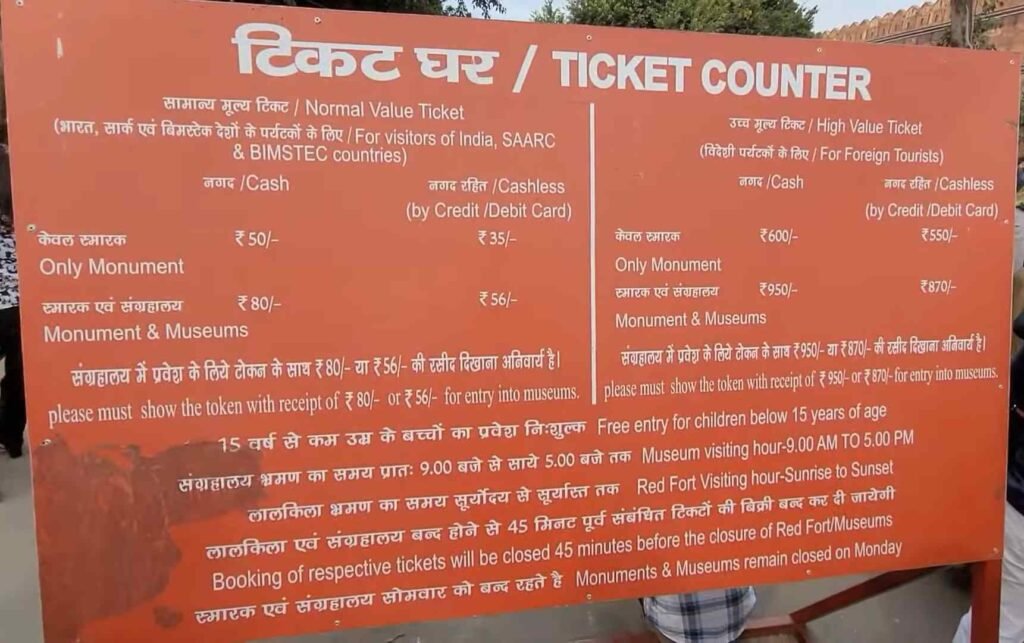
Pingback: Red Fort Delhi: Must-See Attractions and Key Facts - Visitoindia
Red fort is most visited place in delhi.